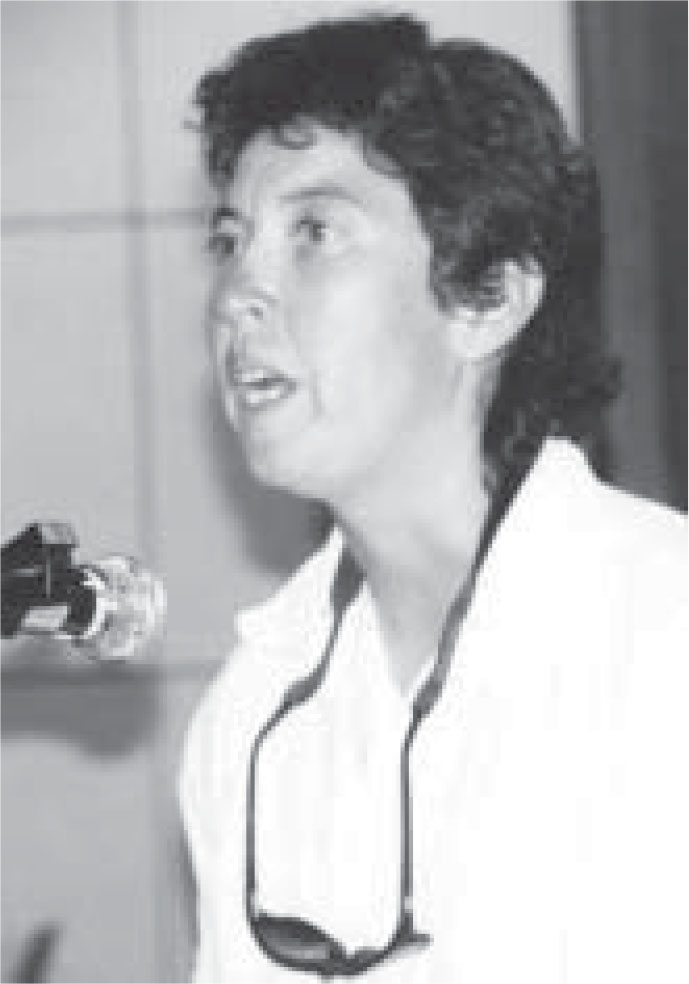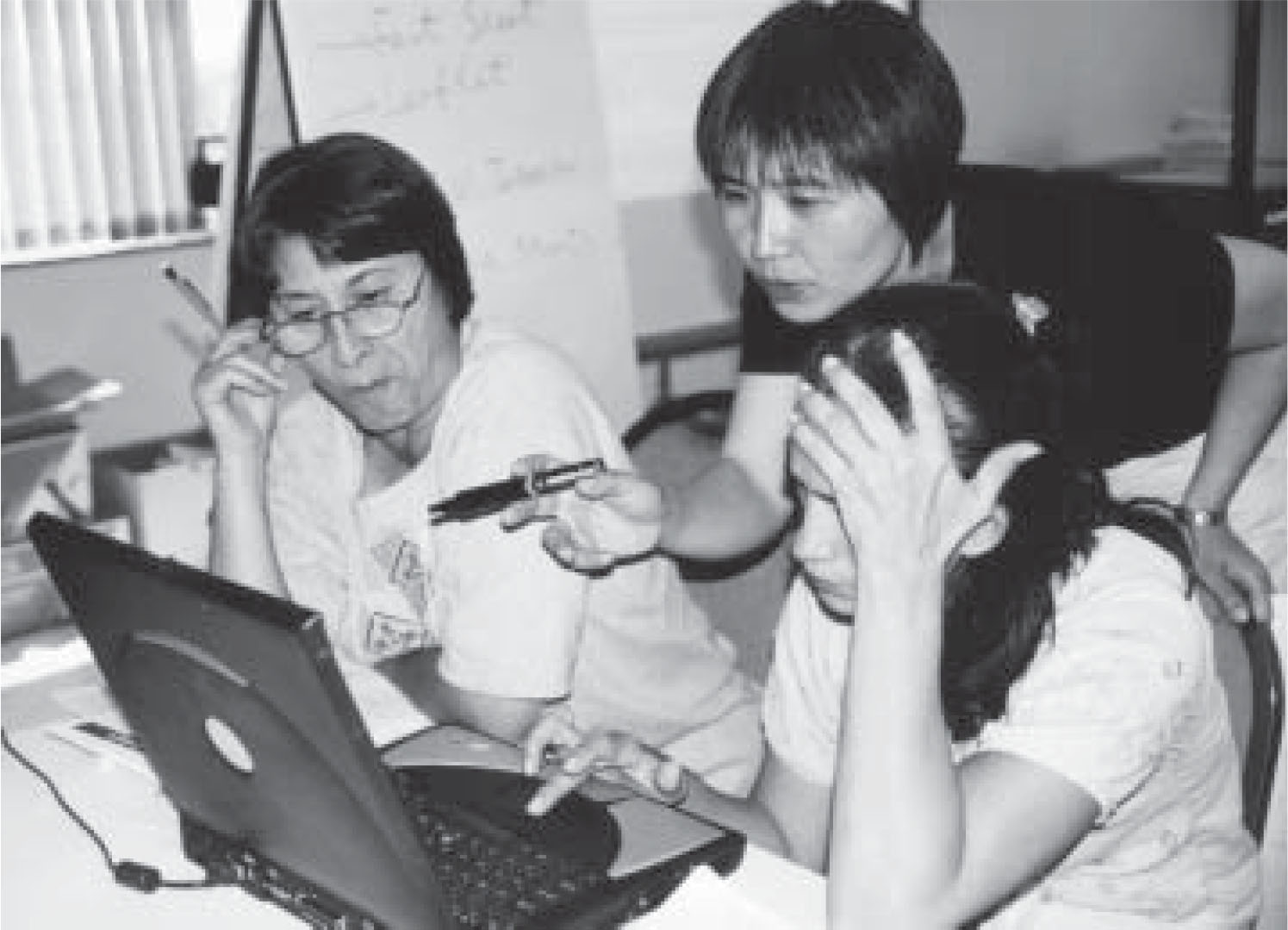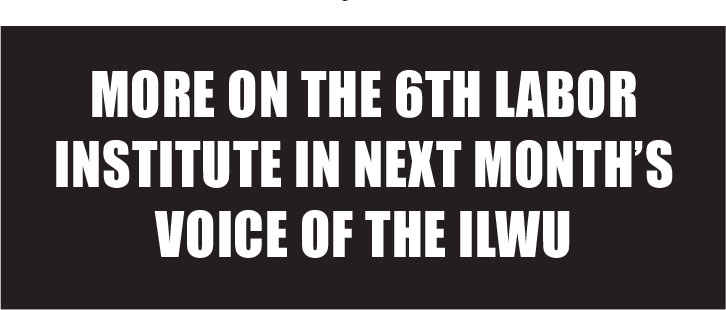HONOLULU—A select group of 92 ILWU members came away from the union’s Sixth Labor Institute with a stronger sense of unity as ILWU members, a renewed commitment to improving the conditions of working people, and the skills and knowledge to make it happen The institute was held from August 25 to 31, 2002, at Tokai University in Honolulu.
The labor institute is a week-long, intensive leadership training program and represents the ILWU’s commitment to education and democratic, rank-and-file unionism where the members run the union. The ILWU holds the labor instituteonce every three years, and six institutes have been held since the program was started in 1987.
“The ILWU is a progressive union and takes education seriously,” Grainger noted.
Robyn Tadio from Hawaii Division spoke on behalf of the new leaders. “This institute totally changed my attitude as a shop steward—it made me more serious,” said Robyn. “I want to thank my business agent for letting me come. We gotta go back and use all the knowledge we gained.”
Robert Flores from Maui spoke from his years of experience as a union leader. “This shows us the power of the union. The only way to get the power is to stick together. Unity is power,” Robert stressed. “Respect yourself first. Stand proud and walk proud.”
Willie Stalker from Lanai probably best expressed the feeling among the labor institute participants. After calling his team of unit officers to the front of the auditorium—Amelia Stalker, Shawn Atacador, and Linda Fernandez— Willie said what everyone felt: “We no longer feel isolated. We have all of you. We have the ammunition we need.”

Robyn Tadio of Unit 1516 - Mauna Lani Bay Hotel & Bungalows. “We gotta go back and use all the knowledge we gained.”
Day 1: Knowledge Is Power Strategic Planning.
On the first day of the Institute, nearly everyone attended one of four workshops on strategic planning. The idea was to get people to think about the purpose and goals of the union and their role as union leaders.
We’re not always conscious about doing it, but everything we do in our lives and work involves planning. When we drive a car, we have a destination in mind and we plan a route to that destination that involves the shortest or fastest driving time. As we work, we make sure we have the necessary equipment and supplies and we plan our actions so we’re not wasting our time and energy.
Planning is even more important for our organizations—like the union or unit organization at our work place. Yet, too often we don’t spend enough time thinking about the goals of our union and developing a plan and strategy to reach these goals. This process is called strategic planning.
The most important objectives of the workshops were to: introduce people to the strategic planning process; help them to understand the process and why it is important to plan strategically; and to show them how to use strategic thinking tools such as S.W.O.T. and S.M.A.R.T. SWOT—which stands for Strengths, Weaknesses, Opportunities, and Threats—is used to analyze the current conditions or environment of the union. SMART—which stands for Specific, Measurable, Assignable, Realistic, and Time-based—is used to develop a workable action plan to reach our goals.
The Strategic Planning workshops were taught by Adrienne Valdez, University of Hawaii Center for Labor Education and Research, and Dawn Addy, Florida International University Labor Center.
“SMART analysis gave groundwork for tackling difficult subjects.” —Lance Kamada.
Workplace Economics and Research for Bargaining. There were four workshops on understanding the economy and how to find financial information about your employer. In the Workplace Economics workshop taught by Bill Boyd, University of Hawaii Center for Labor Education and Research, participants learned about the consumer price index and how to calculate whether their wage increases have kept up with inflation. They learned how to calculate the value of union negotiated benefits such as pensions, medical, vacation, and sick leave. They also got an inside look at how companies manipulate financial data to tell employees they are losing money, while telling investors and stockholders the company is healthy and profitable.
The Research for Bargaining workshop taught by Tracy

Instructor Tracy Chang shows Evelyn Giel and Clem Sweeney how to use the Internet to find financial information about their employers. They learned that one of the most useful sources is the 10-K report publicly traded companies file annually with the US Securities and Exchange Commission and available at www.sec.gov.
Chang, from the University of Alabama at Birmington Labor Center, showed participants how to understand a company’s balance sheet and the meaning of terms such as liabilities, assets, net worth, revenues, and operating expenses. They learned how to use the Internet to get information about their employers. They found the best place to get information about publicly traded companies is from the 10-K report filed with the Securities and Exchange Commission (www.sec.gov). Data on private companies is available for a fee from companies such as Dun & Bradstreet (www.dnbsearch.com).
“Great, learned a lot about research and sources. Things I need to know. She kept us on our toes with helpful information,” Anna Ater.
Understanding the Corporate Strategy. This class taught by Diane Thomas-Holladay, director of the Labor Education Program at the University of Arkansas at Little Rock, was an eye-opener for many participants. They learned how a few very wealthy people in America have become even more wealthy while the vast majority of working families must struggle harder to earn a modest living. They learned how the wealthy control and use the political system to enhance and protect their wealth, while putting a greater burden on the middle class and poor. They learned how the wealthy promote their political agenda through right wing organizations and the Republican Party.
“Learned about how the political system can work for unions or hurt unions.”—Johnny Valera

Why Strategic Planning?
We’re not always conscious of doing it, but everything we do involves planning. Grocery shopping might appear to be a simple task, but it actually involves a number of complex planning steps.
Most of us start by making a list of the food items we need to get or replenish—like if we’re running low on rice or toilet paper or if we need certain items to make a particular dish. We may then look at newspaper ads for sales on those items. Our grocery shopping plan now has a list of items and the stores where those items are on sale.
As we drive to those stores, we usually plan to take the fastest or most direct routes. We also need to make sure we have enough cash on hand, or our driving plan will have to include going to a cash machine or bank.
As we buy the items on our list, we have a plan of how much of the item to buy to last until our next shopping trip. Finally, we know our plan is completed when we buy all the items on the list.
Our simple grocery shopping plan involved at least five planning steps: 1) We started with a purpose—which was to have food to eat; 2) We took inventory of our supplies and made a list of what we needed; 3) We decided which stores to go to and made sure we had enough cash with us; 4) We planned the shortest and fastest route to those stores; 5) We decided on the quantity to buy based on how much we usually eat until our next shopping trip; 6) and we knew our plan was completed when the last item on our list was checked off.
Imagine grocery shopping without a plan. With no grocery list, we would have no idea of what we need. So we buy eggs instead of rice and soap instead of toilet paper. We have no plan of which stores to go to, so we go to any store. We don’t plan our driving, so we drive back and forth and around in circles. We don’t know how much we need, so we buy any amount. With no list, we don’t know if our shopping is completed. Without a plan, our grocery shopping is aimless and we would waste a lot of time, money, and energy.
We wouldn’t think of going grocery shopping without a plan, yet too often, we run our units and other organizations without a conscious plan.
Organizations need the same kind of planning. 1) We need to know our purpose or mission as an organization; 2) Like our grocery list, we need to take stock of our members and our resources—what we have and what we need; 3) We need to set goals to achieve this mission; 4) We need an action plan to achieve these goals—like our driving route in grocery shopping; 5) We need a way to determine if these goals are being achieved. Like checking off our grocery list.
